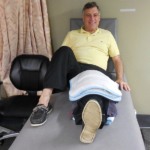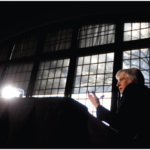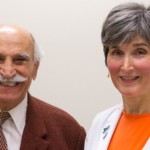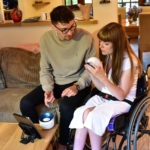How restrictive baby equipment can hinder development
As parents, we rely on convenient places to keep babies safe and contained, but common pieces of baby equipment could be leading to flat heads and muscle strains.

Plagiocephaly, the clinical name for asymmetrical flat-headedness in babies, is relatively common but easily preventable. Parents just need to encourage their babies to defy gravity. Pursuit. University of Melbourne
By Kim Smith, Global News March 12, 2019
Health professionals continue to be concerned about container baby syndrome, which is simply defined as the overuse of restrictive baby equipment.
“In a swing, in a bouncy seat, in any of those items that are going to cuddle and hold that baby in once place,” Lori Grisez said. She’s a board-certified pediatrics clinical specialist and developmental therapist at Nationwide Children’s Hospital in Ohio.
“The baby can’t do their natural movements of wiggling and kicking their arms and legs, trying to lift up their head.”
Other restrictive pieces of baby equipment include floor seats, car seats, high chairs, jumpers, walkers and infant swings, said Grisez.
Grisez said extended time throughout the day in a “container” may lead to plagiocephaly — flat spots on the head — or torticollis — tightness in the neck from keeping the head turned or tilted.
In 2013, a study out of Calgary of 440 healthy Canadian babies found 46.6 per cent had plagiocephaly.
| As parents, we rely on convenient places to keep our babies safe and contained. But common pieces of baby equipment could be leading to flat heads and muscle strains. Kim Smith reports. Global News March 12, 2019 |
Researchers say container baby syndrome has been on the rise since the 1990s when doctors began recommending babies be put to sleep lying on their backs not their tummies to reduce the risk of Sudden Infant Death Syndrome (SIDS). Since then, there’s been a push for parents to encourage tummy time during the daytime.
“We are still not seeing that dramatic increase of that tummy time and still children are spending too much time in containers and on their backs (during the day),” Grisez said.
Grisez said her clinic treats children as young as a few months old with container baby syndrome.
“If a baby isn’t getting enough time to strengthen their muscles and learn to roll over and sit up, it can impact their ongoing developments,” Grisez said. “We want babies to be crawling and getting into things, so they can explore their environment.”
While container time can’t be avoided, parents can encourage development throughout the day. Grisez said helping babies with tummy time can strengthen and improve their development.
Source Global News
| Exercises for babies with plagiocephaly. A five month old baby boy with mild plagiocephaly, or flattening on the back of his head, performs a “pull to sit”. As he is pulled up his head lags and he fails to tuck in his chin, typical of babies with plagiocephaly. Video by Liz Williams. The University of Melbourne. Youtube Jul 11, 2018 |
| References |
The incidence of positional plagiocephaly: a cohort study, Mawji A, Vollman AR, Hatfield J, McNeil DA, Sauvé R. Pediatrics. 2013 Aug;132(2):298-304. doi: 10.1542/peds.2012-3438. Epub 2013 Jul 8.
| Further reading |
Prevalence and characteristics of positional plagiocephaly in healthy full-term infants at 8-12 weeks of life, Ballardini E, Sisti M, Basaglia N, Benedetto M, Baldan A, Borgna-Pignatti C, Garani G. Eur J Pediatr. 2018 Oct;177(10):1547-1554. doi: 10.1007/s00431-018-3212-0. Epub 2018 Jul 20.
Preventing deformational plagiocephaly through parent guidance: a randomized, controlled trial, Aarnivala H, Vuollo V, Harila V, Heikkinen T, Pirttiniemi P, Valkama AM. Eur J Pediatr. 2015 Sep;174(9):1197-208. doi: 10.1007/s00431-015-2520-x. Epub 2015 Apr 1.
Prevention of deformational plagiocephaly in neonates, Cavalier A, Picot MC, Artiaga C, Mazurier E, Amilhau MO, Froye E, Captier G, Picaud JC. Early Hum Dev. 2011 Aug;87(8):537-43. doi: 10.1016/j.earlhumdev.2011.04.007. Epub 2011 Jun 12.
Risk factors for deformational plagiocephaly at birth and at 7 weeks of age: a prospective cohort study, van Vlimmeren LA, van der Graaf Y, Boere-Boonekamp MM, L’Hoir MP, Helders PJ, Engelbert RH. Pediatrics. 2007 Feb;119(2):e408-18. doi: 10.1542/peds.2006-2012
Evidence-based care of the child with deformational plagiocephaly, Part I: assessment and diagnosis, Looman WS, Flannery AB. J Pediatr Health Care. 2012 Jul-Aug;26(4):242-50; quiz 251-3. doi: 10.1016/j.pedhc.2011.10.003.
Evidence-based care of the child with deformational plagiocephaly, part II: management, Flannery AB, Looman WS, Kemper K. J Pediatr Health Care. 2012 Sep-Oct;26(5):320-31. doi: 10.1016/j.pedhc.2011.10.002. Review.
Positional plagiocephaly reduces parental adherence to SIDS Guidelines and inundates the health system, Martiniuk A, Jacob J, Faruqui N, Yu W. Child Care Health Dev. 2016 Nov;42(6):941-950. doi: 10.1111/cch.12386. Epub 2016 Aug 9.
Also see
Container Baby Syndrome: How Equipment Can Hinder a Child’s Development Nationwide Children’s Hospital
How to help babies avoid getting a flat head University of Melbourne
Is Too Much Time in Strollers and Car Seats Harming Your Child’s Development? Healthline






